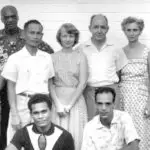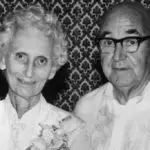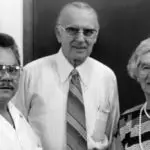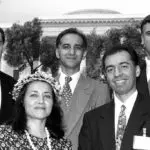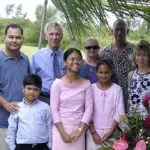Baha'i Faith
Table of Contents
Share This
Baha'i Faith
The Bahá’í Faith has been part of the Guam community since 1954, quietly attracting members from the island’s diverse population. The Mariana Islands Bahá’í Community encompasses both Guam and the Northern Marianas. There are 17 localities in which Bahá’ís reside throughout the islands, six of which have elected administrative bodies called Local Spiritual Assemblies. A national administrative body, known as the National Spiritual Assembly of the Bahá’ís of the Mariana Islands, is located in Hagåtña. Members of the Bahá’í Faith follow the teachings of the prophet Bahá’u’lláh. The following is a statement that from Bahá’u’lláh about religion:
The purpose of religion as revealed from the heaven of God’s holy Will is to establish unity and concord amongst the peoples of the world.
The Bahá’í Faith is an independent world religion that is established in all parts of the world, and whose Bahá’í World Centre is located on Mt. Carmel, in Haifa, Israel.
Beliefs
The word “Bahá’í” means a follower of Bahá’u’lláh. Bahá’ís believe that Bahá’u’lláh is the most recent in the line of Divine Messengers sent by God that stretches back before recorded time and includes Abraham, Moses, Jesus Christ, Buddha, Krishna, and Muhammad.
The main theme of Bahá’u’lláh’s message is unity. He taught that there is only one God, that all the world’s religions represent one changeless and eternal Faith of God, and that all humanity is one race, destined to live in peace and harmony.
A related theme of the Bahá’í Faith is that humanity is a single race and that the day has come for humans to strive for the unification of the world into one global society – a society that embraces this unity while it also preserves the diversity of the human experience.
Among the principles of the Bahá’í Faith are:
- The oneness of humankind
- The elimination of all sorts of prejudice
- The equality of men and women
- The right of every individual to an independent search for truth
- The essential harmony of science and religion
- The elimination of extremes of wealth and poverty
- The promotion of universal education
The Bahá’í community of Guam, like its sister communities in all parts of the world, is actively involved in the development of the individual and society. Bahá’ís do this by engaging in activities such as: devotional gatherings open to people of all faiths; classes for the moral and spiritual education of children within the context of the oneness of humanity and the oneness of religion; and study classes focusing on Bahá’u’lláh’s writings to develop in the individual the skills and spiritual attitudes required for service to humanity and a fruitful and happy life.
Bahá’ís gather for Holy Day celebrations throughout the year, and members of the public are invited to attend these gatherings held either in homes or in the two local centers in Mangilao and Dededo. Many Bahá’í communities also host informal gatherings, called firesides, where inquirers may come to learn more about the Bahá’í Faith, ask questions, and socialize with Bahá’ís.
History in the Mariana Islands
The Bahá’í Faith first reached Guam in 1936, when a Bahá’í from Hawaii, Mary Sweyze, the wife of scientist Dr. Otto Herman Sweyze, joined her husband on a survey to study insects in Guam. They remained in Guam for about seven months, during which time Mrs. Sweyze introduced the Bahá’í Faith to members of the Manibusan family in Sinajana.
It wasn’t until 1954 that two Bahá’ís arrived separately in Guam – Robert Powers Jr. and Cynthia R. Olson. Cynthia’s husband Edgar, better known as Olie, eventually joined her. In July 1954 Mildred Mottahedeh, a well-known Bahá’í of international stature, visited Guam as the first Bahá’í “traveling teacher.” This was followed by the first Bahá’í Holy Day observance, and weekly advertisements of the Bahá’í activities in the Guam Daily News.
In November of that same year, the first presentation of Bahá’í books was made to island libraries. The Bahá’í Fund was established and contributions were soon sent to the Bahá’í International Fund and to a special fund to assist the persecuted Bahá’ís in Iran.
By March 1955, a local resident made the first declaration of his belief in Bahá’u’lláh. The resident, a US civil service worker, was named Charles Mackey. This event was followed by the first mention of the Bahá’í Faith on radio, KUAM, made by Cynthia Olson as part of the “Calendars of the World” program. The “Bahá’í Grapevine,” a newsletter for the Bahá’í community, also commenced publication during 1955.
In 1956, Angeline Isezaki of Humåtak prepared the first Chamorro/CHamoru translation of Bahá’í Writings, “Blessed is the Spot.” The same year, the first Micronesian Bahá’í, Joe Erie Ilengelkei, of Palau, declared his belief in Bahá’u’lláh while living in Guam. Later in 1956, the Guam Department of Education recognized Bahá’í Holy Days and permitted Bahá’í children to be absent from school on those days. In August, the Olsons made their first teaching trip to the island of Rota. And on November 12, 1956 the anniversary of the Birth of Bahá’u’lláh, a series of half-hour radio programs on the Bahá’í Faith began on KUAM radio.
The Spiritual Assembly of the Bahá’ís of Guam formed in 1956 and was officially incorporated in April 1957. The first Bahá’í marriage took place in June of that year, with precedent-setting legal recognition that has remained in effect in Guam to this day. After three milestone years of “firsts,” Shoghi Effendi, the Guardian and Head of the Bahá’í Faith at that time, identified and recorded the Mariana Islands as an “Outstanding Centre” in November of 1957.
In 1966, the first Chamorro Bahá’í, Jesus Blas “Duke” Manibusan of Sinajana, declared his belief in Bahá’u’lláh.
The first National Teaching Committee for Micronesia, appointed by the Hawaiian National Spiritual Assembly as a precursor to the first National Spiritual Assembly of the region, was subsequently formed and based in Guam.
Bahá’ís in Guam traveled and taught their faith throughout the islands of Micronesia, forming four Spiritual Assemblies: two in Pohnpei, one in Chuuk and another in Majuro.
In April 1973, Superior Court of Guam Judge Richard Benson became the first person from Micronesia to be appointed to the Bahá’í Continental Board of Counsellors for Northeastern Asia. This board, now covering Australasia, is composed of eminent Bahá’ís who serve to encourage and protect Bahá’í communities in this region.
In 1978, the National Spiritual Assembly of the Bahá’ís of the Mariana Islands was elected for the first time, and has been elected annually ever since. This institution exercises legislative, judiciary and executive authority in the affairs of the Bahá’í community in the Mariana Islands.
In 1980, the Bahá’ís opened the National Bahá’í Center in Malojloj, Inalåhan. The center was moved to Hagåtña in 2002.
By Leo Babauta and Annette Donner
For further reading
Howe, Tom. “Spiritual legacy now playing dividends.” Baháʼí World News Service, 2 May 2004.
Marianas Bahá’í Community. “Home.”
Pacific Region’s Community Resource Directory. “Bahá’í National Spiritual Assembly.” Organization/Business Detail, 2017.
The Baháʼí Faith: The Official Website of the Worldwide Bahá’í Community. “Home.”

